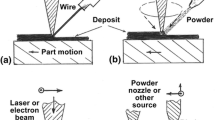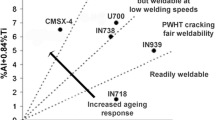Abstract
Additive manufacturing has the potential to revolutionize industrial hardware and unlock efficiency gains through the fabrication of geometries and architectures not possible by conventional processing. Currently, most additive builds use a single set of process parameters which results in a part with a homogenous microstructure that provides a singular performance level. To move beyond this state, a set of computational tools has been developed to track material evolution through each step of the additive process. Computational fluid dynamics and phase field models for microstructure evolution as a function of processing parameters and a crystal plasticity model coupling microstructure and mechanical properties for performance predictions are leveraged to establish a connection between additive parameters, the final microstructure, and mechanical performance. This framework was utilized to tailor spatially-varying mechanical properties in a part by controlling the microstructure evolution during the additive process. Specifically, a turbine blade was 3D-printed from nickel superalloy IN718 using laser powder bed fusion with coarse grains in the airfoil section and finer grains printed in the root of the blade. The benefit of being able to intentionally insert coarse grains in the high-temperature region of the blade was showcased with a microstructure-sensitive creep model that indicates longer creep life for coarser grains.


























Similar content being viewed by others
References
H. Frost, M. Ashby, Deformation-mechanism maps: the plasticity and creep of metals and ceramics (Pergamon Press, Oxford, 1982)
B. Wilshire, C.J. Palmer, Grain size effects during creep of copper. Scr. Mater. 46(7), 483–488 (2002)
K. Nowak, Grain Size dependence of creep lifetime modeled by means of cellular automata. Acta Mech. et Auto. 5(4), 81–85 (2011)
M.L. Santella, P.F. Tortorelli, M. Render, B. Pint, H. Wang, V. Cedro III., X.F. Chen, Effects of applied stress and grain size on creep-rupture lifetime prediction for Haynes 282 alloy. Mater. Sci. Eng. A. 838, 142785 (2022)
D. Taylor, J.F. Knott, Fatigue crack propagation behaviour of short cracks; the effect of microstructure. Fatigue Fract. Eng. Mater. Struct. 4(2), 147–155 (1981)
A. Järvenpää, L.P. Karjalainen, M. Jaskari, Effect of grain size on fatigue behavior of Type 301LN stainless steel. Int. J. Fatigue. 65, 93–98 (2014)
X. Zhu, C. Gong, Y.F. Jia, R. Wang, C. Zhang, Y. Fu, X.C. Zhang, Influence of grain size on the small fatigue crack initiation and propagation behaviors of a nickel-based superalloy at 650° C. J. Mater. Sci. Technol. 35(8), 1607–1617 (2019)
M. Mlikota, K. Dogahe, S. Schmauder, Ž Božić, Influence of the grain size on the fatigue initiation life curve. Int. J. Fatigue. 158, 106562 (2022)
V.M. Barker, W.S. Johnson, B.S. Adair, S.D. Antolovich, A. Staroselsky, Load and temperature interaction modeling of fatigue crack growth in a Ni-base superalloy. Int. J. Fatigue. 52, 95–105 (2013)
Y. Chen, W. Kong, C. Yuan, S. Liu, Y. Cai, Y. Wang, X. Gao, The effects of temperature and stress on the high-cycle fatigue properties of a Ni-based wrought superalloy. Int. J. Fatigue. 172, 107669 (2023)
L. Thébaud, P. Villechaise, C. Crozet, A. Devaux, D. Béchet, J.M. Franchet, J. Cormier, Is there an optimal grain size for creep resistance in Ni-based disk superalloys? Mater. Sci. Eng. A. 716, 274–283 (2018)
B. Navaneeth, S.R. Mungara, R.S. Chidhananda, K.S.T. Reddy, Study of dual grain microstructure heat treatment in steel specimen representing gas turbine rotor disc. Mater. Today. 54, 314–318 (2022)
K. Yagi, K. Kubo, O. Kanemaru, C. Tanaka, Effect of grain size on rupture life under creep-fatigue loading for 321 stainless steel. Mech. Behav. Mat. 4, 583–588 (1991)
K. Kobayashi, K. Yamaguchi, M. Hayakawa, M. Kimura, Grain size effect on high-temperature fatigue properties of alloy718. Mater. Lett. 59(2–3), 383–386 (2005)
B. Du, J. Yang, C. Cui, X. Sun, Effects of grain size on the high-cycle fatigue behavior of IN792 superalloy. Mater. Des. 65, 57–64 (2015)
A. Cruzado, S. Lucarini, J. Lorca, J. Segurado, Crystal plasticity simulation of the effect of grain size on the fatigue behavior of polycrystalline Inconel 718. Int. J. Fatigue. 113, 236–245 (2018)
A. Staroselsky, B.N. Cassenti, Creep, plasticity, and fatigue of single crystal superalloy. Int. J. Solids Struct. 48(13), 2060–2075 (2011)
Y. Miyamato, W.A. Kaysser, B.H. Rabin, A. Kawasaki, R.G. Ford, Functionally graded materials: design, processing and application. Sci. Bus Media. 1(1), 1–339 (1999)
A.J. Goupee, S.S. Vel, Transient multiscale thermoelastic analysis of functionally graded materials. Compos. Struct. 92(6), 1372–1390 (2010)
S.P. Murray, K.M. Pusch, A.T. Polonsky, C.J. Torbet, G.G. Seward, N. Zhou, T.M. Pollock, A defect-resistant Co–Ni superalloy for 3D printing. Nat. Commun. 11(1), 1–11 (2020)
C. Panwisawas, Y.T. Tang, R.C. Reed, Metal 3D printing as a disruptive technology for superalloys. Nat. Commun. 11(1), 1–4 (2020)
R.R. Dehoff, M.M. Kirka, W.J. Sames, H. Bilheux, A.S. Tremsin, L.E. Lowe, S.S. Babu, Site specific control of crystallographic grain orientation through electron beam additive manufacturing. Mater. Sci. Technol. 31(8), 931–938 (2015)
J. Raplee, A. Plotkowski, M.M. Kirka, R. Dinwiddie, A. Okello, R.R. Dehoff, S.S. Babu, Thermographic microstructure monitoring in electron beam additive manufacturing. Sci. Rep. 7(1), 1–16 (2017)
T.T. Roehling, S.S. Wu, S.A. Khairallah, J.D. Roehling, S.S. Soezeri, M.F. Crumb, M.J. Matthews, Modulating laser intensity profile ellipticity for microstructural control during metal additive manufacturing. Acta Mater. 128, 197–206 (2017)
R. Shi, S.A. Khairallah, T.T. Roehling, T.W. Heo, J.T. McKeown, M.J. Matthews, Microstructural control in metal laser powder bed fusion additive manufacturing using laser beam shaping strategy. Acta Mater. 184, 284–305 (2020)
V.A. Popovich, E.V. Borisov, A.A. Popovich, V.S. Sufiiarov, D.V. Masaylo, L. Alzina, Functionally graded Inconel 718 processed by additive manufacturing: crystallographic texture, anisotropy of microstructure and mechanical properties. Mater. Des. 114, 441–449 (2017)
A. Basak, R. Acharya, S. Das, Additive manufacturing of single-crystal superalloy CMSX-4 through scanning laser epitaxy: computational modeling, experimental process development, and process parameter optimization. Metall. Mater. Trans. A Phys. Metall. Mater. Sci. 47, 3845–3859 (2016)
M. Zavala-Arredondo, N. Boone, J. Willmott, D.T. Childs, P. Ivanov, K.M. Groom, K. Mumtaz, Laser diode area melting for high speed additive manufacturing of metallic components. Mater. Des. 117, 305–315 (2017)
R. Acharya, R. Bansal, J.J. Gambone, S. Das, A coupled thermal, fluid flow, and solidification model for the processing of single-crystal alloy CMSX-4 through scanning laser epitaxy for turbine engine hot-section component repair (Part I). Metall. Mater. Trans. B. 45(6), 2247–2261 (2014)
J.D. Hunt, Steady state columnar and equiaxed growth of dendrites and eutectic. Mater. Sci. Eng. A. 65(1), 75–83 (1984)
M. Gäumann, S. Henry, F. Cléton, J.D. Wagnière, W. Kurz, Epitaxial laser metal forming: analysis of microstructure formation. Mater. Sci. Eng. A. 271(1–2), 232–241 (1999)
M. Gäumann, C. Bezençon, P. Canalis, W. Kurz, Single-crystal laser deposition of superalloys: processing–microstructure maps. Acta Mater. 49(6), 1051–1062 (2001)
W. Kurz, C. Bezençon, M. Gäumann, Columnar to equiaxed transition in solidification processing. Sci. Tech. Adv. Mat. 2(1), 185 (2001)
P. Liu, Z. Wang, Y. Xiao, M.F. Horstemeyer, X. Cui, L. Chen, Insight into the mechanisms of columnar to equiaxed grain transition during metallic additive manufacturing. Addit. Manuf. 26, 22–29 (2019)
R. Acharya, J.A. Sharon, A. Staroselsky, Prediction of microstructure in laser powder bed fusion process. Acta Mater. 124, 360–371 (2017)
G.A. Knorovsky, M.J. Cieslak, T.J. Headley, A.D. Romig, W.F. Hammetter, Inconel 718: A solidification diagram. Metall. Mater. Trans. A Phys. Metall. Mater. Sci. 20, 2149–2158 (1989)
W.J. Boettinger, J.A. Warren, C. Beckermann, A. Karma, Phase-field simulation of solidification. Annu. Rev. Mater. Res. 32, 163–194 (2002)
S. Ghosh, N. Ofori-Opoku, J.E. Guyer, Simulation and analysis of γ-Ni cellular growth during laser powder deposition of Ni-based superalloys. Comput. Mater. Sci. 144, 256–264 (2018)
B. Shassere, D. Greeley, A. Okello, M. Kirka, P. Nandwana, R. Dehoff, Correlation of microstructure to creep response of hot isostatically pressed and aged electron beam melted Inconel 718. Metall. Mater. Trans. A. 49(10), 5107–5117 (2018)
ASTM F3055-14a.: Standard specification for additive manufacturing nickel alloy (UNS N07718) with powder bed fusion and AMS 5663. ASTM International, West Conshohocken, PA (2021)
J. Reiser, A. Hartmaier, Elucidating the dual role of grain boundaries as dislocation sources and obstacles and its impact on toughness and brittle-to-ductile transition. Sci. Rep. 10, 2739 (2020)
Y. Lin, J. Pan, H.F. Zhou, H.J. Gao, Y. Li, Mechanical properties and optimal grain size distribution profile of gradient grained nickel. Acta Mater. 153, 279–289 (2018)
A. Staroselsky, B.N. Cassenti, Combined rate-independent plasticity and creep model for single crystal. Mech. Mater. 42(10), 945–959 (2010)
L. Borkowski, M. Anahid, A. Staroselsky, W. Hu, Microstructure-sensitive large-deformation model for thermomechanical processing simulations. Int. J. Solids Struct. 230, 111161 (2021)
A. Staroselsky, Damage and cracking morphology (In Advances in Fracture and Damage Assessment of Materials. WIT Press, UK, 2004)
Y. Huang, J.W. Hutchinson, V. Tvergaard, Cavitation instabilities in elastic-plastic solids. J. Mech. Phys. Solids. 39(2), 223–241 (1991)
X.P. Xu, A. Needleman, Void nucleation by inclusion debonding in a crystal matrix. Model. Simul. Mat. Sci. Eng. 1(2), 111 (1993)
M. Daňa, I. Zetková, J. Mach, Mechanical properties of Inconel Alloy 718 produced by 3D printing using DMLS. J. Manuf. Technol. 18(4), 559–562 (2018)
M.C. Chaturvedi, Y. Han, Creep deformation of alloy 718. Superalloys. 718, 489–498 (1989)
R.Z. Aminov, A.B. Moskalenko, A.I. Kozhevnikov, Optimal gas turbine inlet temperature for cyclic operation. J. Phys. 1111(1), 12046 (2018)
Acknowledgements
This material is based upon work supported by the Department of Energy under Award Number(s) DE-FE0031642. Disclaimer: "This presentation was prepared as an account of work sponsored by an agency of the United States Government. Neither the United States Government nor any agency thereof, nor any of their employees, makes any warranty, express or implied, or assumes any legal liability or responsibility for the accuracy, completeness, or usefulness of any information, apparatus, product, or process disclosed, or represents that its use would not infringe privately owned rights. Reference herein to any specific commercial product, process, or service by trade name, trademark, manufacturer, or otherwise does not necessarily constitute or imply its endorsement, recommendation, or favoring by the United States Government or any agency thereof. The views and opinions of authors expressed herein do not necessarily state or reflect those of the United States Government or any agency thereof."
Author information
Authors and Affiliations
Corresponding author
Additional information
Publisher's Note
Springer Nature remains neutral with regard to jurisdictional claims in published maps and institutional affiliations.
Special issue credit line: This invited article is part of a special topical focus in the journal Metallography, Microstructure, and Analysis on Microstructure Modeling.
Rights and permissions
Springer Nature or its licensor (e.g. a society or other partner) holds exclusive rights to this article under a publishing agreement with the author(s) or other rightsholder(s); author self-archiving of the accepted manuscript version of this article is solely governed by the terms of such publishing agreement and applicable law.
About this article
Cite this article
Acharya, R., Borkowski, L., Fisher, B. et al. Computational Tools for Additive Manufacture of Tailored Microstructure and Properties. Metallogr. Microstruct. Anal. 12, 906–923 (2023). https://doi.org/10.1007/s13632-023-01023-4
Received:
Revised:
Accepted:
Published:
Issue Date:
DOI: https://doi.org/10.1007/s13632-023-01023-4




